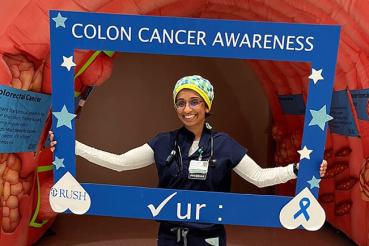Despite remarkable advances in the detection and treatment of colorectal cancer, it remains the second-largest cause of cancer mortality in the United States.
What makes this unique among the other cancers for which we have screening tools is that prevention is also possible. This is because we can identify and remove premalignant lesions before they become cancer. So what accounts for the stark contrast between our known ability to prevent, detect and cure this cancer and this grim statistic?
Lack of screening. The most common sign and symptom of early colon cancer is actually nothing at all. That’s why we so strongly recommend screening (before you have any symptoms) for colorectal cancer.
Current guidelines recommend colorectal cancer screening for adults between the age of 45 and 75. This may start earlier for those at higher risk. You may have a higher risk if you have family history of colorectal cancer, chronic inflammatory bowel disease, or polyposis syndromes. If you have questions about your risk factors, please ask your physician. It is never too early to start the discussion on when to start screening.
It's also important to know when to stop. After the age of 75, we recommend screening on an individual basis. Those age 85 or older no longer need a screening.
There are a variety of recommended screening tests. The gold standard is colonoscopy, which provides both screening and prevention. Colonoscopies detect early stage cancers, but also allow your doctor to remove precancerous lesions called polyps. Removing polyps can potentially prevent cancer from developing.
Polyps are very common: About one in four people screened will have polyps, and the vast majority of polyps will never develop into cancer. But as all cancers arise from a polyp, we remove them when we find them. If we find polyps, we recommend having a colonoscopy again in three to five years, depending on the size and number of polyps. If no polyps are found, there is no family history of colorectal cancer, and the views in the colon were adequate, a colonoscopy may only need to be done every 10 years.
No matter your age, if you are having symptoms (bleeding, rectal pain, sudden change in bowel habits or frequency), you should be evaluated by a physician. Common things being common, you’re still more likely to have a nonmalignant cause, but it is important to not assume it.
Moving beyond procedural fears
Screening works. According to a 2010 study published in the journal Cancer, the incidence and mortality dropped by more than 30% over a 15-year period due to screening.
However, in many populations, especially in rural, poor and among some ethnic groups, screening rates remain as low as 40%, according to a 2018 Health Services Research Administration report. Screening is still woefully underused, leaving more than 23 million adults who have gone without screening despite access to health care after the passage of the Affordable Care Act, reports the Centers for Disease Control and Prevention.
To try to close the gap in screening, an aggressive initiative was launched by the National Colorectal Cancer Roundtable and American Cancer Society in 2014 to have 80% of the population screened by 2018. While the results are still pending, progress has been made. And it’s encouraging to know that if we can consistently increase screening rates to 80%, we can save more than 203,000 lives by 2030. To reach this goal, we still need to overcome many barriers.
The fear of what the procedure involves remains a hurdle. While considered invasive, colonoscopy is a routine, outpatient, one-day procedure performed under conscious sedation for comfort.
Other fears exist around the inability to tolerate the bowel preparation. Over the last few years, there has been significant improvement in the types of laxatives used in the bowel prep, with availability of much smaller-volume and better-tasting options. A formulation using tablets is also available.
Also, easing up a bit on the dietary restrictions the day before and splitting the dose of the prep makes the process more palatable than ever.
Furthermore, there are other options in screening tests including stool-based tests for microscopic evidence of blood, DNA tests and CT scans.
The benefit of these screening tests is that they are noninvasive, yet appropriate for screening. The drawback is that they’re not preventive since they don’t allow for polyp removal. However, ultimately, the best test is the test that gets done.
Testing helps you know your risk
A common misconception is that if you live a healthy lifestyle, have no family history and have no symptoms, you are not at risk for colon cancer. While there is some evidence that engaging in a healthy diet and lifestyle may modestly reduce your risk of developing colorectal cancer, the most modifiable risk factor is failure to get screened.
Also, while a family history increases your background risk by two to three times, a lack of a family history is not protective. The lifetime risk of developing colorectal cancer is as frequent as one in 20, and the majority of patients who are newly diagnosed do not, in fact, have a family history of cancer.
Even though it’s fairly well known that signs of colon cancer may include rectal bleeding, a low blood count or change in bowel habits and stool caliber, the truth is that the most common symptom of early colon cancer is, again, nothing at all. Half of those who are diagnosed after symptoms develop will die from cancer. That’s why screening is so important and cannot wait until you feel unwell.
The stakes are massive. Demystifying the process and options in colorectal cancer screening is imperative. Please join us in raising awareness for colorectal cancer throughout March. The tragedy of dying from colorectal cancer is that it is entirely treatable, curable — and even preventable.




